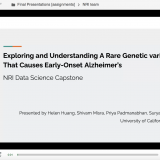Exploring and understanding a rare genetic mutation that causes early-onset Alzheimer’s

About the Project
How has a present day population been shaped by the risk of Alzheimer's disease? This population genetics project seeks to understand a rare, variant genetic mutation that causes early-onset Alzheimer’s disease.
With access to a data set made up of the full genome sequences from hundreds of individuals in Columbia, the capstone team's first goal will be to trace how far back the mutation/mutations responsible for said disorder go. Identifying common ancestors and the timeframe when the first mutation occurred can provide key insights into whether or not the mutation was the result of potential selective advantage. Another goal of the project is to estimate the age of each variant of the disease.
This rewarding project introduces exciting biology concepts and terminology, as well as software and tools for analyzing genotype data.
Student Team
- Helen Huang
- Shivam Misra
- Priya Padmanabhan
- Pugal Surya
- Rey Yue
Mentors
- Juliana Acosta Uribe, Sponsor
- Ken Kosik, Sponsor
- Joshua Bang, TA
- Alex Franks, Faculty
Presentation
About NRI and Prof. Kosik's Neurobiology Lab
The mission of the Neuroscience Research Institute (NRI) is to foster knowledge and understanding of the nervous system by serving as a center for scientific research breakthroughs. The NRI is a group of investigators whose collective goal is to create an intellectual atmosphere conducive to exploration at the frontiers of human knowledge where disciplinary boundaries disappear. Investigators in the NRI recognize that the interests of neuroscience extend broadly from repair and prevention of human disease to the principles that underlie the development and function of nervous systems, from the human mind to the single molecular building blocks of the brain.
The Kosik lab is interested in fundamental biological processes related to the brain and evolution. Using the cellular, molecular, genetic and bioinformatic tools, and cutting edge technologies including single cell RNA-sequencing, microelectrode array, stem cell derived organoids, and CRISPRi screening, we are trying to understand the underlying molecular mechanism of neuroplasticity and neurodegenerative diseases.
